The Best New York-style Bagel Recipe
One of the staples in my kitchen, this New York style bagel recipe is super easy to make and well worth the effort! Crispy on the outside, just like your favorite NY deli, but baked in your own kitchen. These homemade bagels are the real deal!
Other NY favorites that are a must-try include weck rolls (kimmelweck rolls; hard rolls) and bialys!
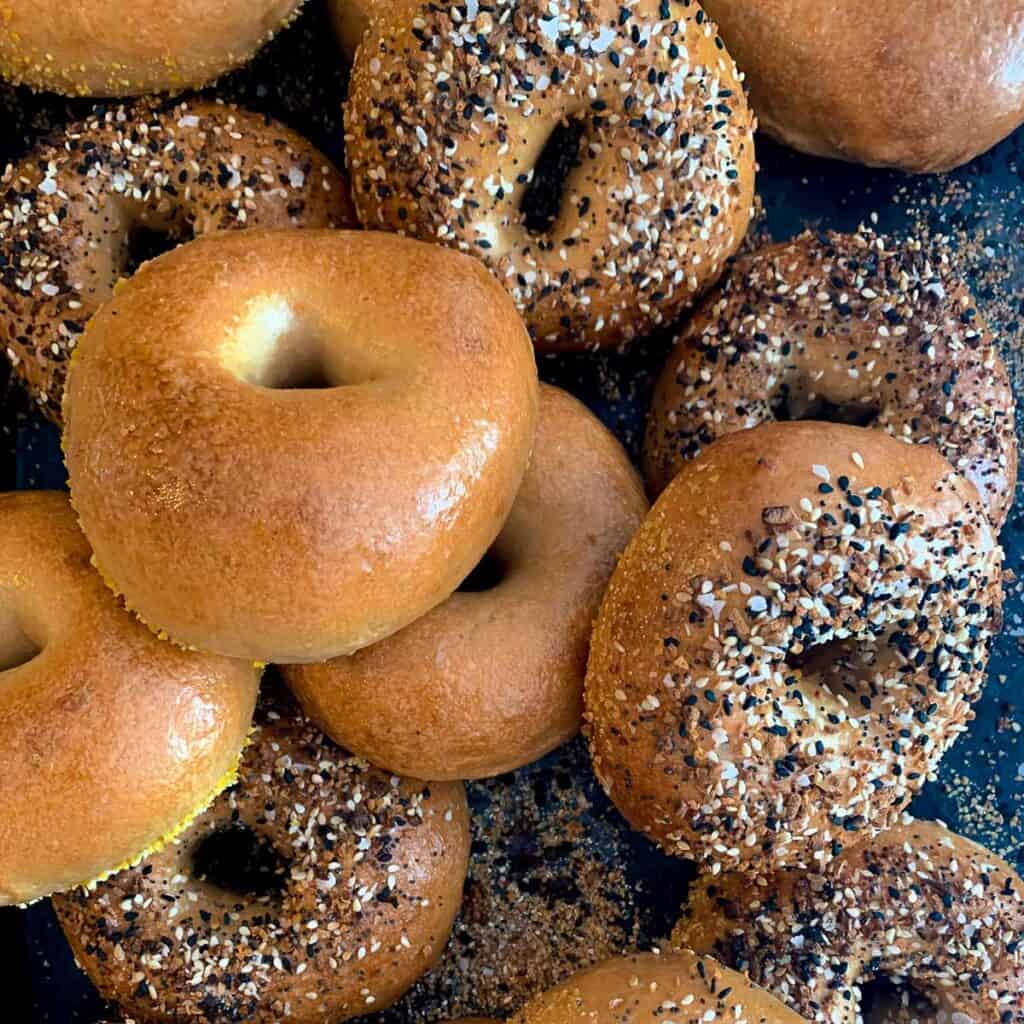
Jump to:
What is a NY Bagel?
I am SOO excited to share this recipe for NY style bagels (authentic bagels), which I absolutely love (as much or even more than my favorite NY pizza dough).
I must say, these bagels are amazing!!! And, they are totally worth the effort. Even around these parts, it’s difficult to get “real” bagels.
Sadly, many many versions of bagel recipes are just “bagel-shaped rolls”!!
And so, before we get much further, you should know what a real NY bagel is!
An authentic New York bagel is a culinary icon that has gained legendary status worldwide. What makes it truly remarkable is the perfect balance of characteristics that come together to create a bagel experience like no other.
Outer Crust: The crust of an authentic NY bagel is a thing of beauty. It is glossy, golden-brown, and delicately crisp. The exterior has a slight resistance when bitten into, giving way to a satisfying chewiness that sets it apart from other bread products.
Chewy Texture: The hallmark of a New York bagel is its exceptional chewiness. It possesses a dense yet tender interior that offers just the right amount of resistance when you bite into it. This chewiness is achieved through a combination of factors, including the unique dough formulation, boiling before baking, and the addition of key ingredients.
Malty Flavor: An authentic NY bagel has a distinct malty flavor that sets it apart. This signature taste is attributed to the inclusion of barley malt syrup or malt extract in the dough or boiling water. The malt adds a subtle sweetness and complexity that elevates the overall flavor profile, making each bite a delightful experience.
Proper Size and Shape: Authentic NY bagels are typically hand-rolled and shaped into a classic circular form with a hole in the center. This traditional size and shape contribute to the bagel’s texture and create the perfect vessel for a variety of fillings or spreads.
Boiling Process: One of the defining characteristics of an authentic NY bagel is the boiling process before baking. This step helps achieve the unique texture and shine on the crust. Boiling the shaped dough briefly in water sets the outer crust while keeping the interior soft and chewy. It creates a slight gelatinization on the surface, contributing to that coveted glossy appearance.
Freshness and Quality Ingredients: The best NY bagels are made with high-quality ingredients and baked fresh. The use of high gluten/bread flour, water, yeast, salt, and barley malt syrup ensures a flavorful and authentic result. Additionally, the absence of preservatives in freshly baked bagels enhances their taste and texture.
Versatility: An authentic NY bagel is a versatile canvas for various toppings, spreads, or fillings. Whether it’s cream cheese, lox, butter, eggs, or any other creative combination, the bagel can accommodate a wide range of flavors and textures, allowing for endless possibilities to suit individual preferences.
Ingredients
You may have most of these ingredients on hand. If you don’t, it is certainly quite easy to keep these ingredients in stock going forward.
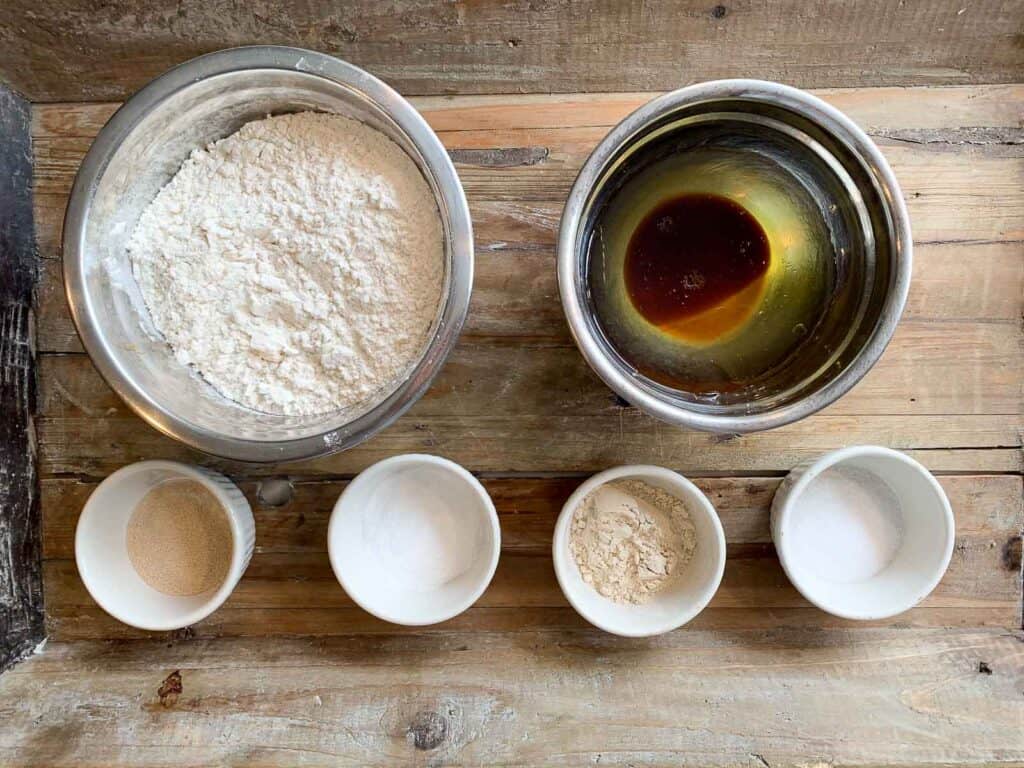
Overview of Process
I usually opt to make overnight bagels. For this easy process, you will:
- Mix and knead the dough until fairly smooth
- Divide the dough into 8 pieces (115 grams or 4 ounces each piece)
- Roll the 8 pieces into balls
- Poke a hole in each ball and shape into bagels
- Place on greased baking sheet and let rest/rise in refrigerator overnight or on counter for same day bagels.
- Boil bagels in batches of 3 or 4 (30 to 45 seconds, up to 2 minutes, on each side)
- Drain over pot using slotted spoon and placed on baking sheet lined with parchment
- Bake at 450 degrees for 15 to 20 minutes.
Mixing and Easy Shaping Technique
I make my bagels the night before I want to enjoy them. It takes me about 30 minutes of mixing and measuring and then some hands off time to let dough rest. I then shape them, and put them away for next day baking.
The photo collage below shows an overview of the steps needed.
Mix dry ingredients (photo 1), and then mix the wet ingredients (photo 2). Then, combine the wet and dry ingredients and knead using hands or an upright stand mixer (photo 3).

After kneading the dough and ensuring you have a smooth dough (photo 4), (about 10 minutes by hand) you will divide the dough into 8 equal portions (115 grams or 4 ounces each piece) (photo 5) and shape each piece into balls (photo 6).
Now if you are like me, you will use a scale to help ensure that all pieces are similar in weight so that your bagels are all pretty close in size, but it’s not necessary to do so!
Personally, I find the easiest way to shape bagels is to form balls and then poke a hole right in the middle of the ball of dough (photo 7). Then, using your fingers, you stretch the center out to create a 2-inch center hole.
After forming the bagels, place on a baking tray and cover with plastic wrap that has been sprayed with cooking oil (photo 8).
I like to use a silicone baking sheet because I’ve found that it decreases the chance of over-browning the underside of the bagels. Place the covered bagels directly into the refrigerator for next day baking.
Increasing Flavor
I always opt to refrigerate my bagels after shaping them in order to slow the rise. This also increases flavor, as slow rise dough enhances the fermentation of the dough. In the morning, you simply boil and bake the bagels and you’ll have fresh bagels within an hour or less!

Boiling the Bagels and Suggested Toppings
Just prior to baking, you will prepare a kettle bath (see below) that can include just plain ole water or water with a flavoring like barley malt syrup, brown sugar, or honey, and salt.
I used water and a tablespoon or so of barley malt syrup for flavoring. Really no measuring required here – Just ensure the water is deep enough to allow the bagels to float and that the water has a nice warm color (if you opt to add flavoring).
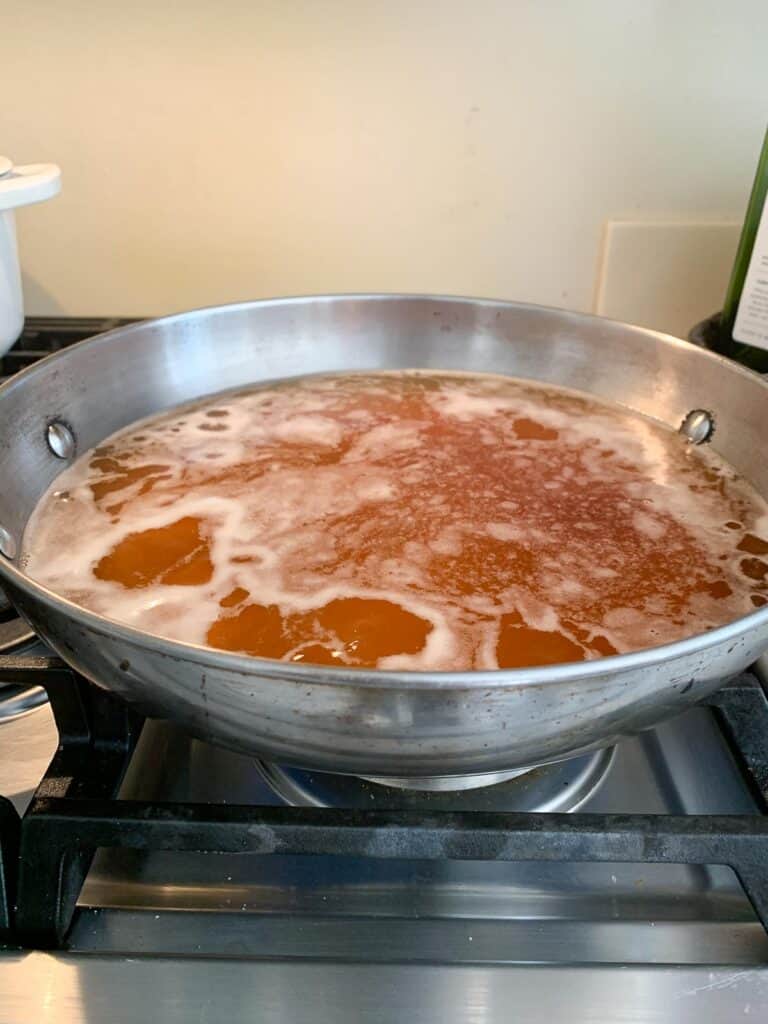
I feel that the use of the kettle bath with barley malt syrup gives these bagels that truly distinct NY bagel flavor, and it also sets the crust before baking, giving you that bagel-y chewy crust and dense interior. If you don’t have barley malt syrup, don’t worry! Use brown sugar or honey instead.
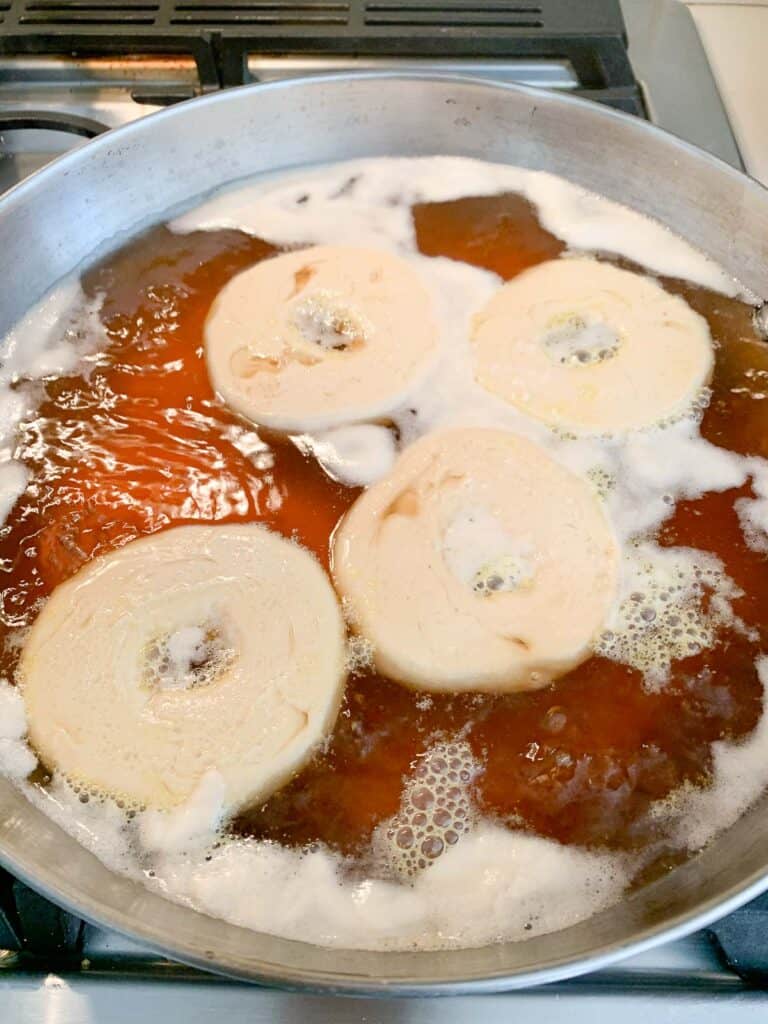
*Make sure your kettle water is boiling well because this is also where your bagels will grow in size (as well as during baking). The photo is a bit deceiving as it doesn’t truly show the rolling boil, which is important to obtain.
Here’s what my bagels looked like after the kettle bath and after topping. Pictured below are plain bagels, poppy seeds bagels, and “everything topping” bagels (poppy seeds, sesame seeds, dried minced garlic, dried minced onion, and coarse salt). There is also cornmeal sprinkled on bottom.
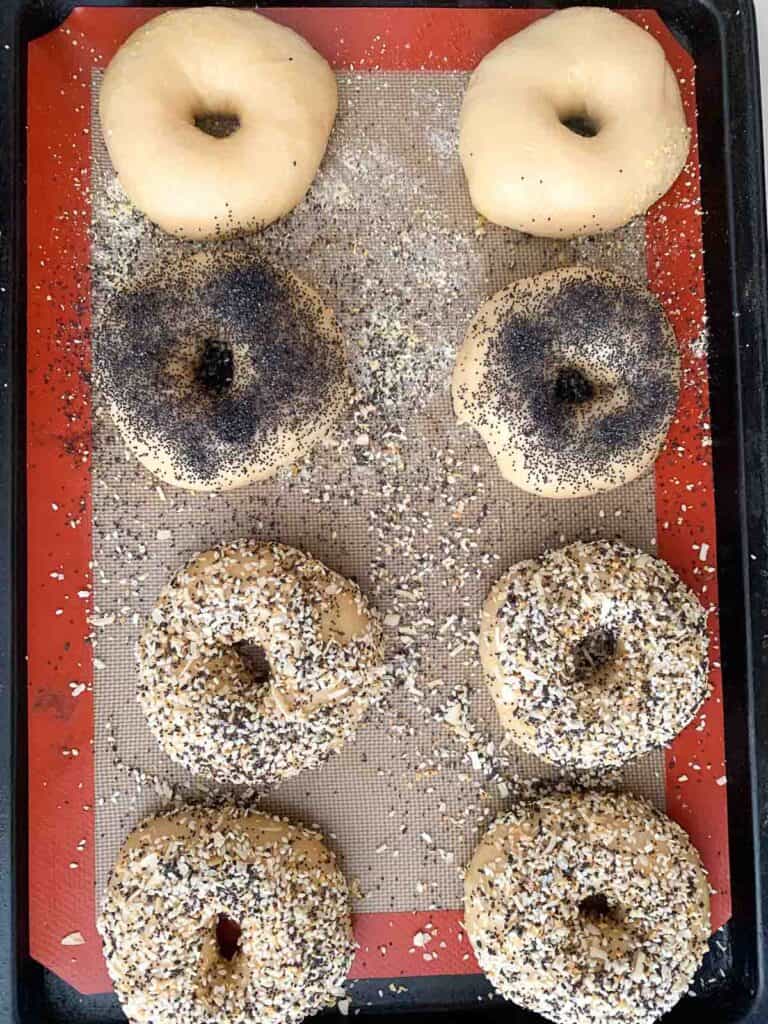
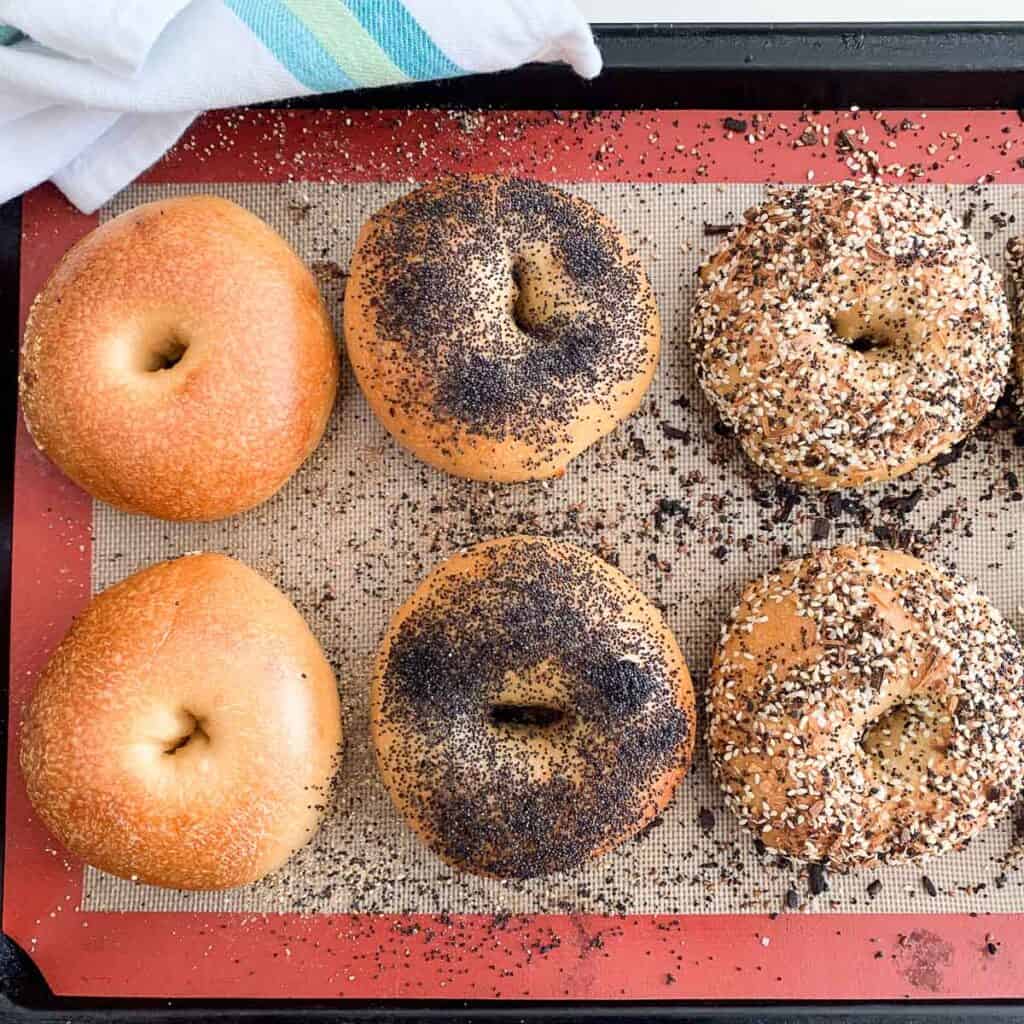
Barley Malt Syrup
This recipe uses (optionally!) barley malt syrup, which isn’t commonly found in grocery stores. I buy it at my local health food store or online. If you don’t have it on hand, don’t worry, there are substitutes!
Barley malt syrup is a thick, dark brown syrup made from sprouted barley grains. It is created through a process that involves soaking barley in water, allowing it to germinate, and then drying and grinding the sprouted barley. This mash is then cooked down to create a concentrated syrup.
Barley malt syrup is known for its distinctive malty flavor, which adds a unique depth to baked goods.
In baking, barley malt syrup serves several purposes and is widely used in various recipes, including bread, bagels, muffins, and cookies. Here are some of its most common uses in these baked goods:
Bread: Barley malt syrup is often added to bread dough to enhance flavor and contribute to a soft and tender texture. It helps retain moisture, promotes browning, and adds a subtle malty sweetness. Recipes like malted wheat bread, pumpernickel bread, and rye bread commonly feature barley malt syrup.
Bagels: Barley malt syrup is a key ingredient in traditional bagel recipes. It not only provides sweetness but also plays a crucial role in achieving the distinctive chewy texture and glossy appearance of bagels. It is used both in the dough and in the boiling water during the preparation process.
Muffins: Barley malt syrup can be found in some muffin recipes, particularly those that benefit from its unique malty flavor. It adds complexity and depth to flavors, making muffins like malted chocolate muffins or malted banana muffins stand out.
Cookies: Some cookie recipes, such as malted oatmeal cookies or malted chocolate chip cookies, utilize barley malt syrup to enhance their flavor profiles. The syrup contributes a subtle sweetness and a distinct malty taste that pairs well with other ingredients.
Substitutes for Barley Malt Syrup
The best substitutes for barley malt syrup when it’s unavailable or for those seeking alternatives are as follows:
Molasses: Molasses is a commonly recommended substitute for barley malt syrup. It is a thick, dark syrup produced during the sugar refining process. Although it has a slightly different flavor profile, molasses provides a similar depth and richness. Use molasses as a 1:1 replacement, adjusting liquid content if necessary.
Honey: Honey offers a natural sweetness and can be used as a substitute for barley malt syrup. While it has a distinct flavor, it complements baked goods well. Replace barley malt syrup with an equal amount of honey, considering the sweetness level and adjusting liquid content as needed.
Maple Syrup: Maple syrup is another viable option. It imparts a unique and pleasant flavor to recipes. Use it as a 1:1 substitute for barley malt syrup, considering the different consistency and adjusting liquid content accordingly.
Brown Sugar: Brown sugar, although not an exact substitute, can provide sweetness in place of barley malt syrup. Keep in mind that it lacks the malty flavor and enzymatic activity. Use brown sugar as a replacement based on desired sweetness, considering adjustments to moisture levels and other liquids in the recipe.
Top Tips
- Use a good quality flour; I always try to use bread flour but you can also use a good all-purpose flour (make sure it has at least 3 to 4 grams protein per serving on nutrition label). Higher is better.
- Consider using vital wheat gluten, which is widely available in supermarkets. Vital wheat gluten will increase the protein content of the flour and give you more crisp and chew.
- Make sure you knead the dough well; usually this dough is hand kneaded because it is a pretty tough to knead using conventional mixers. (However, this recipe is a bit easier to mix than other traditional doughs because it has a bit more water in it).
- When you get to the boiling stage, make sure your kettle/water bath is deep enough for the bagels to float in and replenish the water if it boils off too much for second batch (assuming you are boiling 3 or 4 at a time).
- Make sure your bagels float in water before the boiling stage, as this is a sign that they have risen enough! Fill a medium sized bowl with water, and drop one in, making sure it rises to the top! if it does, your ready to boil them.
- Make sure the kettle water reaches a rolling boil, otherwise, the bagels will not puff up a lot during this stage.
- If the water isn’t deep enough in the boiling pan, the bagels can stick to the bottom of the pan.
- You can boil the bagels for 45 seconds to 2 minutes on each side; taking care to flip them over gently. If the bagels deflate in the water, they proofed too long (risen too much).
- The longer boiling time will give you a thicker crust and shorter times result in thinner crust. To begin, use the shorter boiling times listed.
- Egg wash is NOT needed; the kettle bath gives these bagels a nice shiny finish.
- Barley malt syrup can be found on Amazon or at the health food store; if you can’t find it, don’t worry, use honey, molasses, or brown sugar.
- I use parchment or silicone baking sheets to prevent over browning on the bottom of bagels.
- More tips on making great bagels from New Yorker Bagels
- Also see Troubleshooting bagels from Serious Eats
Storage
Bagels keep for 1 day at room temperature when stored in a paper bag. After 1 day, slice bagels and freeze them in plastic bags for up to one month. Thaw or toast bagels after freezing.
📖 Recipe
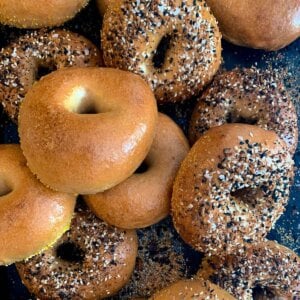
Authentic New York-style Bagels
Equipment
- baking sheets
- Large shallow pot (deep enough for at least 3 or 4 bagels to float in water.)
- Slotted spoon helpful to remove bagels from boiling water.
Ingredients
For The Dough:
- 4 1/3 cups (541.67 g) bread flour*
- 1 teaspoon dry yeast (overnight bagels) (1 tablespoon for same-day bagels)
- 1 tablespoon sugar
- 2 teaspoons honey, molasses, or barley malt syrup. updated from brown sugar
- 2 teaspoons salt
- 1 1/3 cups (315.45 g) warm water (overnight bagels) (add 3.5 tablespoons of water per batch for same day bagels)
- 1 tablespoon vegetable oil
- 1 tablespoon vital wheat gluten (*optional*) OPTIONAL, 1. to 1.5 tablespoons (increases the protein content of flour)
For the kettle water:
- (3 quarts) water (just use enough to allow at least 3 or 4 bagels to float without touching bottom of pan)
- (1 tablespoon) brown sugar, honey, or barley malt syrup** (enough to tint water golden color; can also simply use plain water)
- 1/2 teaspoon (1/2 teaspoon) salt
For baking:
- cornmeal enough to dust baking sheets
OPTIONAL "everything bagel topping" (or purchase already mixed)***:
- 2 tbsp Sesame seeds
- 2 tbsp Poppy seeds
- 1 tbsp Dried minced onion
- 2 tsp Dried minced garlic
- 1 tsp Coarse salt
Instructions
To Mix the Dough:
- Add all dry ingredients to a medium sized bowl or in the bowl of a standing mixer and blend.
- Note: Please see directions on your brand of yeast. If it requires activation by adding water and/or sugar, use some from the amounts stated in the recipe. RedStar/SAF (instant or active yeast) does NOT require activation but Fleishman's active dry yeast does.
- Add wet ingredients (oil and water) to dry ingredients and knead until dough in smooth (10 to 12 minutes in mixer or as long as needed by hand; may also knead in food processor for up to 90 seconds and finish by hand kneading if needed). If using food processor, you may need to split dough into two batches depending on size of appliance.
- Do a window pane test: take a small walnut sized piece of dough and try to stretch it out very thinly until it is almost "transparent" – this suggests your dough has been kneaded enough.

- Rest the dough for 10 minutes and then divide into eight pieces (if weighing about 115 grams or 4 ounces for each bagel). This is a low-hydration dough – you MUST keep the dough covered at all times.
- Shape dough pieces into balls by rolling on countertop using slight pressure from palm of your hand, and then let the balls rest on counter for 10 to 15 minutes.
- Spray a baking sheet with cooking spray, sprinkle with cornmeal, and set aside.
- Poke hole in center of each balls with your index finger and form into bagels by gently stretching the hole out to about 2 inches in width, and then place on prepared baking sheet.
For Same Day Baking
- Cover bagels with plastic wrap (spray tops of bagels or bottom of wrap so it doesn't stick to bagels) and let bagels rise for about 20 minutes in warmer weather or 30 minutes in cooler kitchens. (Float test: Bagels are ready for boil and bake if they float in a bowl of water.)
For Next Day Baking
- Spray top of bagels with cooking spray and top with plastic wrap, place in the refrigerator, and then proceed the next day by following "To Boil and Bake Bagels" section below. No need to bring bagels to room temperature after refrigerating. (Float test: Bagels are ready for boil and bake if they float in a bowl of water.)
To Boil and Bake the Bagels
- Preheat oven to 450 degrees (Do NOT use convection)
- In the meantime, bring kettle water to a boil in a large flat pan with deep sides (saute pan or broiler pan). Remember to do the float test (bagels are ready for boiling once they float in a bowl of water, and not sink to the bottom; you'll only need to test one.)
- When water is boiling, add bagels to water (enough to fit without crowding) and boil bagels for about 30 to 45 seconds and then flip them over and boil for another 30 to 45 seconds on the other side. (You can boil for up to 2 minutes per side but note that the bagels may be more apt to deflate during a longer boil or if they are slightly overproofed.)
- Drain bagels using slotted spoon and place onto a baking sheet that has been dusted with cornmeal.
- If desired, top with your favorite bagel topping (ie, everything seasoning) or leave them plain.
- Place bagels into the oven and bake for 15 to 20 minutes until golden (begin checking bagels at about 13 minutes). You can use parchment or silicone baking mat but I've often also used simply cornmeal dusted plain baking sheet.
Storage
- Bagels are best enjoyed the same day as baking. For leftovers, slice and freeze in airtight bag.
To Make the Everything Topping
- Mix all ingredients together and store extra in plastic bag.
Notes
- Use a good quality flour; I always try to use bread flour but you can also use a good all-purpose flour (make sure it has at least 4 grams protein per serving on nutrition label)
- Consider using vital wheat gluten, which is widely available in supermarkets. Vital wheat gluten will increase the protein content of the flour and give you such a beautiful crisp and chew.
- Make sure you knead the dough well; usually this dough is hand kneaded because it is a pretty tough to knead using conventional mixers. (This recipe is a bit easier to mix than other traditional doughs because it has a bit more water in it).
- When you get to the boiling stage, make sure your kettle/water bath is deep enough for the bagels to float in and replenish the water if it boils off too much for second batch (assuming you are boiling 3 or 4 at a time).
- Make sure the kettle water reaches a rolling boil, otherwise, the bagels will not puff up a lot during this stage.
- If the water isn’t deep enough in the boiling pan, the bagels can stick to the bottom of the pan.
- You can boil the bagels for 30 t0 45 seconds (up to 2 minutes) on each side; taking care to flip them over gently. If the bagels deflate in the water, they proofed too long (risen too much) or were boiled for too long.
- The longer boiling time will give you a thicker crust and shorter times result in thinner crust. To begin, use the shorter boiling times listed.
- Egg wash is NOT needed; the kettle bath gives these bagels a nice shiny finish (using convection setting will blow bagels dry and decrease shine).
- I sometimes use parchment or silicone baking sheets to prevent over browning on the bottom of bagels.
Nutrition
*Recipe updated on July 15th to add more detailed instruction and adjust yeast and water for overnight proofing.






I have been looking for the perfect bagel recipe and this one was the best one yet! The bagels were so yummy! Awesome recipe.
I may be missing it but is their a rising period after the dough is kneaded & before boiling? Making tomorrow
Hi Dawn, great question. after shaping, rest bagels for about 20 minutes and then test to see if they float using a bowl of water . If one floats, they’re ready to be put in fridge for baking the next morning or for same day version, ready for boiling and baking.
Overall, the flavor of these bagels is absolutely fantastic. However, I’ve tried both the overnight version and the same-day version with not-quite-perfect (but consistent) texture results. I feel the directions could use a bit more clarity on time and steps, so I figured I’d ask in case others have the same issues:
1. When doing the overnight, I followed the recipe and timings exactly, but it didn’t say how long to leave it in the fridge. The first time, I did about 12 hours and they ended up not rising much in the boil or bake (though the crust and texture were pretty good). The second time, I did about 18 hours and they rose a little bit more but still weren’t anything like in the photos.
2. When doing the same-day, I followed all of the exact same timings (bulk rise for 15, balls rose for 20, shaped bagels rose for 30) and they got huge (looked like perfect bagels) but then immediately deflated and turned to discs in the water. They were clearly overproofed so I tried again without the first bulk rise (shaping right away) and they ended up too dense.
3. The same-day version says to increase the yeast and water. I’ll admit I have more experience making traditional bread, but this seems backwards to me: wouldn’t you want to reduce hydration and yeast for the same-day since the overnight version would lose some moisture in the fridge and would rise more slowly? I’d love an explanation of the reason for that, since I’m curious!
Thanks!
Glad you like the flavor and you have some great questions!
1. I would recommend doing the “float test” to see if your bagels have risen enough, Place a bagel in a bowl of water and see if it floats; if so, it is ready.
2. I would reduce the yeast slightly and/or you can reduce the boiling time to 30 seconds per side.
3. increasing the yeast and the water speeds up the leavening process. if you use less yeast, your bread dough will rise more slowly and the fermentation time will be longer producing a product that is better tasting. More water allows for more activity (yeasts can move around more quickly) from what I understand – hope this helps a bit.
Also, assuming your bagels are not overproofed, remember that the kettle bath is use to puff up the bagels and “wake the yeast up from their nap” in the case of overnight refrigeration . Make sure you have a nice strong boil going.
Delicious NY style bagels! I love NY style bagels, but unfortunately there are very few places in my metro area to get them, and none are close to me.
I have ZERO faith in my breadwork, but these turned out great! They recipe was easy to follow. The bagels came out with a great chew and good texture. I did three plains, three everything, and two dukkah spiced.
Awesome! 👏👏 I just made another batch too! I like to slice and freeze the leftovers
I’m a New York transplant and I discovered this recipe during quarantine. I’ve been so excited to have actual bagels that remind me of home! I was a bigger fan of the original recipe (which uses the quantity listed in the same-day version, but still with a cold rise). The bagels I associate with home are not very puffy and more of a dense chew, with a good crust, and that recipe accomplished that for me! I just made a few refinements- I re-stretch the bagels just before their bath (this ensures less puff and a good solid hole in the middle), quickly add the everything topping immediately after their bath while still wet and pat it on with my hands to the tops & sides of the bagels (the topping stays on better this way), I place the bagels on two baking sheets, 4 per sheet (they were not baking evenly because they were too close to each other on one sheet), and I bake them for longer than the given time to make sure the inside gets baked through (if the outside is getting too brown I throw some foil over them). I will be using this recipe for a long time!
I’ve made several bagel recipes from online blogs and I found this recipe not as good as other’s Ive tried. Bagels deflated and did not have a good crust. After cooling from baking they feel “soggy”.
deflating is a sign of overproofed dough – and good crust comes from nice strong flour, an extended boil (which is not possible if bagels overproofed) and mixing the dough well. Sorry it didn’t work out for you…if you want to trouble shoot and try again, please feel free to contact me via email.
The recipe was great ! My only issue is that I end up with flagels not bagels !! Flat bagels . I form them at night, refrigerate and cover the bagels overnight. In the morning, I remove them from the refrigerator and wait for signs of their beginning to puff up prior to boiling and baking. They become quite delicate to handle prior to boiling . The taste is great. Maybe I should boil and bake after rising for 1 hour for a same day bake.
Any thoughts ?
Yes! Great timing I am in the midst of updating this recipe, which was originally posted as a “same day” recipe…to make a long story short, reduce yeast to 1 teaspoon and make sure to use bread flour for overnight version. Bagels usually deflate when they are boiled if they are overproofed. I’ll have more details added too when I update the post.
Thank you for this recipe- I am a hero to my daughter who enjoys avocado on a toasted bagel.
Awe – she sounds like my kinda girl! Yummm
Turned out perfect!!! Will be making again and again.
Glad to hear it! I’m due to make some too
Thank you for this recipe. My college girls (as well as the other 2 still in HS) have been asking for bagels and I let time get away from me and both have to drive back today.
So I searched for recipes permitting same-day make-and-bake and was very happy to find yours.
One quick comment on ingredient order. Using a stand mixer, I followed the instructions including adding the Tbs of vegetable oil after the water/malt had been blended into the dry ingredients. I ended up with a dough ball merrily spinning round the (now quite oily) mixer bowl instead of being kneaded. Not a real problem as I simply hand-kneaded for a couple of minutes to incorporate the oil then tossed it back in the mixer for the remaining specified time.
Anyway, I added the oil a bit at a time over maybe 30 seconds. Does it work better to dump it all in at once? Or maybe add it in as the wet/dry are nearly, but not fully, blended together?
Thank you again.
I’m glad it worked out overall! I think the oil should be added just after the flour has been mostly absorbed but well before the ball stage so I’ll clarify -thanks for the feedback 🙂
Thanks! Although the one-day version were really, *really* great, I’m in-progress with the 2-day version right now. I have the bagels shaped and in the fridge and will boil and bake around 6 am tomorrow. I did this time add the oil a bit earlier as suggested and it worked out fine.
Thanks again for posting this great recipe. I can’t believe how easy and good these are!
I added my 1 tablespoon of oil to the warm water and than added that combination to the dry ingredients. My bagels were absolutely delicious, perfect except the already mixed everything topping got too brown, as the onions cooked too quickly. Next time after 13 minutes I’m going to cover the bagels with a piece of foil to hopefully prevent burnt toppings.
Good idea! Or maybe you can lower the tray so the top doesn’t brown as much? I have heard of people soaking their topping too but I like your idea of simply covering lightly after a certain time
These were great but I have one question. How do you get the seeds to stay on? They stick on after the water bath but all come off when you try to eat them or handle them. Maybe an egg wash after the water bath?
I think it’s normal for some to fall off but maybe because I put so much topping on that I don’t have trouble? If you sprinkled to place topping maybe try dipping them instead in a bowl of the topping?
What was the resolution about yeast and flour. I made this this morning after proofing overnight in fridge. The dough is very tacky and the shape falls apart, but after the boil and bake, they are ugly but delicious! A little flat, and I’m sure some small tweak Would alleviate the issue. I’m not a baker so I look to you for guidance. Texture is amazing.
The resolution is, if proofing overnight, reduce yeast to 1 teaspoon (instead of 1 tablespoon) and also reduce water to 300 mls. Dough will be harder to work with but much less chance of deflation and crust will be much improved
Thanks, Marie. The flavor and texture of these bagels is exceptional—it was just the deflation. I will try with the reduced yeast and water.
Sorry to bug you again, but I have trouble with your volume to weight conversions. For the water in these bagels, I would have shown a weight of 354 g for 1 1/2 cups, not 333 g (i.e. 1 cup water = 236 grams times 1.5 = 354 g). Which measurement is correct?
Thanks,
Michael
Yes you’re correct it’s 354:) I’ll update it soon (about a difference of 1.5 tb or so) thank you for pointing this out
Are you using active dry or instant yeast in your recipe? That can make a HUGE difference to how these turn out. Looks like a solid recipe though.
I use instant but have used active in the past too.
This article may have preceded the sale of Whole Foods to Amazon but the Barley Malt Syrup. Whole Foods (in Saint Paul, Minnesota) DOES NOT CARRY Barley Malt Syrup.
Thanks for the heads up! I’ve noticed this too so I’ll update the recipe…I always find it at the local health food store
I know, Whole Foods used to have great bread baking ingredients but now I have to go to the Coop to get things like barley syrup and semolina.
A shame they have become just another supermarket (expensive at that!).
Thanks for the recipe!
Thank you!! I have just made these and the are delicious. As an American in London, one of my great laments was the lack of “New York” bagels. These are the closest I have come and on my first attempt.